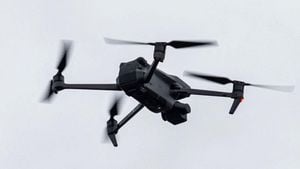The George Washington Carrier Strike Group has kicked off its participation in the U.S.-Japan-South Korea trilateral multi-domain exercise, known as Freedom Edge, which began on Wednesday and is expected to wrap up on Friday. This marks the second iteration of the exercise, imbuing greater significance against the backdrop of heightened regional tensions due to North Korea's recent missile tests.
North Korea's military provocations, which included the launch of an Intercontinental Ballistic Missile (ICBM) on October 31 and subsequent Short Range Ballistic Missile launches on November 5, have escalated concerns among its neighbors. Following North Korea's ICBM launch, the U.S. joined forces with Japan and South Korea for a joint air drill on November 3, deploying powerful assets including U.S. Air Force B-1 bombers alongside fighter aircraft from all three nations. "The three countries strongly condemned North Korea’s provocation which undermines peace and stability, particularly on the Korean Peninsula," said the South Korean Joint Chiefs of Staff (JCS), highlighting the rationale behind this military collaboration.
Freedom Edge aims to bolster the defensive capabilities of the U.S., Japan, and South Korea and symbolizes their commitment to maintaining regional stability. This year’s exercises are taking place amid intensifying military activities not just from North Korea, but also as South Korea and Pyongyang forge stronger ties with both Western powers and Russia. The exercise is situated south of South Korea’s Jeju Island and is set to demonstrate the capabilities of fifth-generation fighters integrated within multi-domain defense networks.
Throughout the exercise, the USS George Washington (CVN-73), equipped with Carrier Air Wing (CVW) 5, will operate alongside destroyers from the American fleet, including USS Higgins (DDG-76), USS McCampbell (DDG-85), and USS Dewey (DDG-105). Japan and South Korea are contributing their strongest naval assets as well, with Japan deploying Aegis destroyer JSHaguro (DDG-180), various fighter jets, and maritime patrol aircraft like the P-3C Orion. South Korea’s contingent includes the Aegis destroyer ROKS Seoae Ryu Seong-ryong (DDG-993) and F-35 Lightning II fighters, among others.
Adding complexity to the situation is the emergence of unprecedented military agreements between North Korea and Russia. Recently, North Korea's leader Kim Jong-un ratified a significant defense pact with Russia, which includes provisions for mutual military assistance. This development has raised alarms, as it coincides with reports claiming North Korean troops have been deployed to assist Russia's military operations.
Just as these exercises were reaching their peak, Japan made headlines with the unexpected cancellation of its planned bilateral ordnance exercise with the U.S. following the loss of crew on the Japanese minesweeper JS Ukushima (MSC-686), which tragically sank after suffering from fire. This mishap caused Japan to redirect its military focus during the drill.
The naval exercises are not restricted to mere surface-level operations. On another front, the Republic of Korea Navy has embarked on testing uncrewed aerial vehicle (UAV) capabilities from the flight deck of its amphibious assault ship. This marks the first attempt of its kind for the South Korean Navy and reflects the broader strategic shift toward unmanned systems within naval operations.
During the recent operational trials, the South Korean Navy successfully launched the UAV, believed to be the General Atomics Aeronautical Systems’ Mojave model, from the ROKS Dokdo (LPH-6111). Following its launch, the UAV conducted simulated landing maneuvers, proving South Korea's advancements toward incorporating unmanned systems within its maritime defense strategy.
This increased focus on interoperability, technology integration, and the evolution of military capabilities among the U.S., Japan, and South Korea showcases their unwavering stance against growing North Korean threats and sets the stage for future collaborations amid changing geopolitical dynamics.
The overarch of these exercises is clear: as North Korea continues its military provocations alongside burgeoning partnerships with nations like Russia, the trilateral collaboration among the United States, Japan, and South Korea is becoming increasingly significant. Freedom Edge is just one facet of the broader strategic alignment taking place, aiming to secure stability, peace, and effective deterrence against shared threats.
With military activities ramping up surrounding the Korean Peninsula, these trilateral exercises are becoming not only routine drills but are imbued with pressing geopolitical significance. The success and outcomes of Freedom Edge, as well as other collaborative efforts, will likely set the tone for future engagements within this strategic region.



